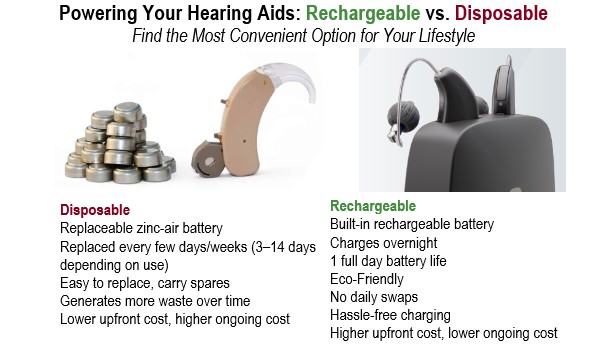Powering Your Hearing Aids
Hearing aids require a reliable power source to deliver clear, consistent sound and performance. The choice of a hearing aid battery will impact on convenience, cost, and lifestyle. Traditionally, hearing aids use disposable batteries, which are easy to replace, widely available, and allow you to carry spares for travel or emergencies. However, they require frequent replacement and generate ongoing costs over time.
In recent years, rechargeable hearing aids have become popular and are becoming the norm. These devices eliminate the need for frequent battery replacements, allowing users to simply charge their hearing aids overnight or within several hours and enjoy a full day of uninterrupted hearing. Rechargeable hearing aids are also more environmentally friendly and particularly helpful to individuals with limited dexterity or vision, who find handling tiny batteries challenging.
Choosing between disposable and rechargeable options depends on your daily routine, hearing aid usage, and personal preference. Factors such as lifestyle, travel habits, and convenience play a key role in deciding which solution best meets your needs.

Types of Hearing Aid Batteries
Disposable Zinc-Air Hearing Aid Batteries.
Disposable hearing aid batteries are zinc air based because they require oxygen in order to operate. They begin to work once the tab is removed, which allows the air to be exposed to the battery pack. The battery begins to lose power as soon as the tab is removed, therefore only pull once ready to use.
Colours & Sizes of Zinc-air disposable Hearing Aid Batteries
Available in 3 sizes, disposable zinc-air hearing aid batteries are colour and number coordinated to make it easier to remember the right size for your hearing aids. What is important to know when selecting the correct battery size for your hearing aid is the compatibility and lifespan of each battery.
Here’s a guide you can use:
- Yellow Tab / Size 10 - Compatible to custom Completely-In-Canal (CIC) and Receiver-In-Canal (RIC) hearing aids with a 5 - 7 days lifespan.
- Brown Tab / Size 312 - Compatible to custom In-The-Ear (ITE), In-The-Canal (ITC) and Receiver-In-Canal (RIC) hearing aids with a 7 - 10 days lifespan.
- Orange Tab / Size 13 - Compatible to custom In-The-Ear (ITE), Behind-The-Ear (BTE), and Behind-The-Ear (BTE) with slim tubing hearing aids with a 10 - 14 days lifespan.
Rechargeable Li-Ion (Lithium-Ion) hearing aid batteries are charged each night, with each charge giving close to 30 hours of performance to the hearing aid and lasting as long as 5 years approximately, before they require replacing by the hearing aid manufacturer. This can be a positive when you think of all the tab removals and regular battery replacing you could skip, as a result of using a rechargeable battery. Presently, rechargeable Li-Ion batteries are only available for Behind-The-Ear (BTE), Receiver-In-Canal (RIC) and select universal and custom fit In-The-Ear (ITE) hearing aids due to their size.
Rechargeable NiMH hearing aid batteries have a number of advantages over disposable zinc-air, from cost effectiveness, being environmentally friendly and having a longer lifespan. In addition to this, users will not need to worry about their batteries failing during important moments as they deliver power all day long, achieving a better quality of life.
Rechargeable Hearing Aids: A Modern Power Source
Rechargeable hearing aids use built‑in batteries (typically lithium‑ion) that you recharge rather than replace. This option is widely available across many styles—especially behind‑the‑ear (BTE) and receiver‑in‑canal (RIC) models—offering a convenient alternative to disposable batteries.
Some of the leading brands offering rechargeable hearing aids include:
- Phonak – For example the Audéo series, known for long battery life and fast‑charging.
- Signia – Models like Charge & Go and Pure Charge&Go with rechargeable options in various styles.
- Starkey – High‑end rechargeable hearing aids with robust features and portable charging cases.
- Oticon – Rechargeable models offering connectivity and modern sound processing.
Convenience & Benefits
- You simply place the hearing aids on their charger overnight and they’re ready to use the next day—no tiny batteries to swap.
- Many models provide a full day of use, even with streaming and Bluetooth active.
- Environmentally friendly: fewer disposable batteries to buy and discard.
- Easier for users who have limited dexterity or vision: no fiddling with small battery compartments.
- Modern models often include features like quick‑charge (e.g., a few minutes of charging gives several hours of use) and portable charging cases for travel.
